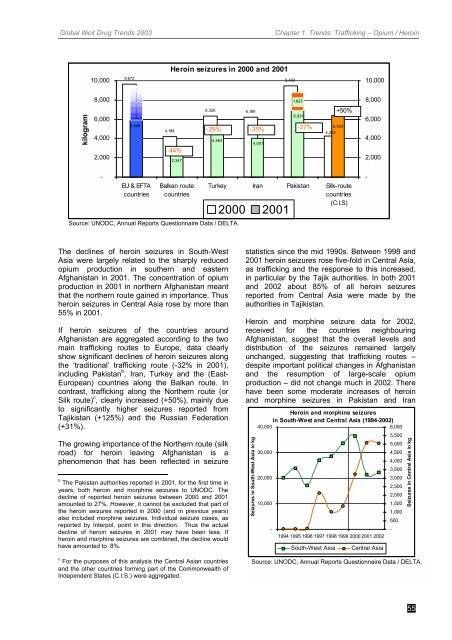global illicit drug trends 2003 - United Nations Office on Drugs and ...
global illicit drug trends 2003 - United Nations Office on Drugs and ...
global illicit drug trends 2003 - United Nations Office on Drugs and ...
You also want an ePaper? Increase the reach of your titles
YUMPU automatically turns print PDFs into web optimized ePapers that Google loves.
Global Illicit Drug Trends <str<strong>on</strong>g>2003</str<strong>on</strong>g><br />
Chapter 1. Trends: Trafficking – Opium / Heroin<br />
Heroin seizures in 2000 <strong>and</strong> 2001<br />
10,000<br />
9,672<br />
9,492<br />
10,000<br />
8,000<br />
1,825<br />
8,000<br />
kilogram<br />
6,000<br />
4,000<br />
2,000<br />
5,896<br />
4,198<br />
-44%<br />
2,347<br />
6,326 6,189<br />
6,931<br />
-29% -35% -27%<br />
4,464<br />
4,001<br />
4,262<br />
+50%<br />
6,393<br />
6,000<br />
4,000<br />
2,000<br />
-<br />
EU & EFTA<br />
countries<br />
Balkan route<br />
countries<br />
Source: UNODC, Annual Reports Questi<strong>on</strong>naire Data / DELTA.<br />
Turkey Iran Pakistan Silk-route<br />
countries<br />
(C.I.S)<br />
2000 2001<br />
-<br />
The declines of heroin seizures in South-West<br />
Asia were largely related to the sharply reduced<br />
opium producti<strong>on</strong> in southern <strong>and</strong> eastern<br />
Afghanistan in 2001. The c<strong>on</strong>centrati<strong>on</strong> of opium<br />
producti<strong>on</strong> in 2001 in northern Afghanistan meant<br />
that the northern route gained in importance. Thus<br />
heroin seizures in Central Asia rose by more than<br />
55% in 2001.<br />
If heroin seizures of the countries around<br />
Afghanistan are aggregated according to the two<br />
main trafficking routes to Europe, data clearly<br />
show significant declines of heroin seizures al<strong>on</strong>g<br />
the ‘traditi<strong>on</strong>al’ trafficking route (-32% in 2001),<br />
including Pakistan b , Iran, Turkey <strong>and</strong> the (East-<br />
European) countries al<strong>on</strong>g the Balkan route. In<br />
c<strong>on</strong>trast, trafficking al<strong>on</strong>g the Northern route (or<br />
Silk route) c , clearly increased (+50%), mainly due<br />
to significantly higher seizures reported from<br />
Tajikistan (+125%) <strong>and</strong> the Russian Federati<strong>on</strong><br />
(+31%).<br />
The growing importance of the Northern route (silk<br />
road) for heroin leaving Afghanistan is a<br />
phenomen<strong>on</strong> that has been reflected in seizure<br />
b<br />
The Pakistan authorities reported in 2001, for the first time in<br />
years, both heroin <strong>and</strong> morphine seizures to UNODC. The<br />
decline of reported heroin seizures between 2000 <strong>and</strong> 2001<br />
amounted to 27%. However, it cannot be excluded that part of<br />
the heroin seizures reported in 2000 (<strong>and</strong> in previous years)<br />
also included morphine seizures. Individual seizure cases, as<br />
reported by Interpol, point in this directi<strong>on</strong>. Thus the actual<br />
decline of heroin seizures in 2001 may have been less. If<br />
heroin <strong>and</strong> morphine seizures are combined, the decline would<br />
have amounted to 8%.<br />
c<br />
For the purposes of this analysis the Central Asian countries<br />
<strong>and</strong> the other countries forming part of the Comm<strong>on</strong>wealth of<br />
Independent States (C.I.S.) were aggregated.<br />
statistics since the mid 1990s. Between 1998 <strong>and</strong><br />
2001 heroin seizures rose five-fold in Central Asia,<br />
as trafficking <strong>and</strong> the resp<strong>on</strong>se to this increased,<br />
in particular by the Tajik authorities. In both 2001<br />
<strong>and</strong> 2002 about 85% of all heroin seizures<br />
reported from Central Asia were made by the<br />
authorities in Tajikistan.<br />
Heroin <strong>and</strong> morphine seizure data for 2002,<br />
received for the countries neighbouring<br />
Afghanistan, suggest that the overall levels <strong>and</strong><br />
distributi<strong>on</strong> of the seizures remained largely<br />
unchanged, suggesting that trafficking routes –<br />
despite important political changes in Afghanistan<br />
<strong>and</strong> the resumpti<strong>on</strong> of large-scale opium<br />
producti<strong>on</strong> – did not change much in 2002. There<br />
have been some moderate increases of heroin<br />
<strong>and</strong> morphine seizures in Pakistan <strong>and</strong> Iran<br />
Seizures in South-West Asia in kg<br />
Heroin <strong>and</strong> morphine seizures<br />
in South-West <strong>and</strong> Central Asia (1994-2002)<br />
40,000<br />
6,000<br />
30,000<br />
20,000<br />
10,000<br />
-<br />
1994 1995 1996 1997 1998 1999 2000 2001 2002<br />
South-West Asia<br />
Central Asia<br />
5,500<br />
5,000<br />
4,500<br />
4,000<br />
3,500<br />
3,000<br />
2,500<br />
2,000<br />
1,500<br />
1,000<br />
Source: UNODC, Annual Reports Questi<strong>on</strong>naire Data / DELTA.<br />
500<br />
-<br />
Seizures in Central Asia in kg<br />
55
















